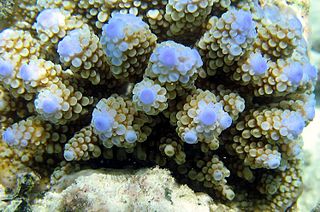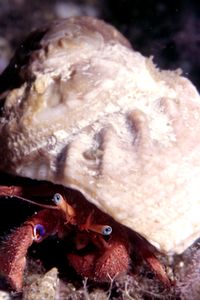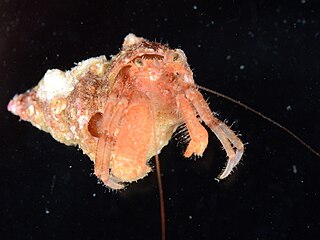
Velella is a monospecific genus of hydrozoa in the Porpitidae family. Its only known species is Velella velella, a cosmopolitan free-floating hydrozoan that lives on the surface of the open ocean. It is commonly known by the names sea raft, by-the-wind sailor, purple sail, little sail, or simply Velella.

Hydractinia echinata is a colonial marine hydroid which is often found growing on dead, hermit-crabbed shells of marine gastropod species. This hydroid species is also commonly known as snail fur, a name which refers to the furry appearance that the hydroids give to a shell.

Hydractinia symbiolongicarpus is one of the 30 + Hydractinia species known worldwide. This saltwater animal, from here on referred to as Hydractinia, is at the base of the Cnidaria phylum and in many ways, is similar to the freshwater Hydra. In the wild, Hydractinia feed on smaller invertebrates found in the shallow mud, however in laboratory environments they are fed brine shrimp. Hydractinia symbiolongicurpus and its sibling species, Hydractinia echinata, are the two species from the genus Hydractinia on which most work has been published.

Acroporidae is a family of small polyped stony corals in the phylum Cnidaria. The name is derived from the Greek "akron" meaning "summit" and refers to the presence of a corallite at the tip of each branch of coral. They are commonly known as staghorn corals and are grown in aquaria by reef hobbyists.
Pocillopora inflata is a species of stony coral in the family Pocilloporidae. It was first described by Peter William Glynn in 1999. It is found growing on coral reefs in the tropical eastern Pacific Ocean but is nowhere abundant.

Obelia longissima is a colonial species of hydrozoan in the order Leptomedusae. Its hydroid form grows as feathery stems resembling seaweed from a basal stolon. It is found in many temperate and cold seas world-wide but is absent from the tropics.

Acropora secale is a species of branching staghorn stony coral. It is found in shallow parts of the Indo-Pacific Ocean and the type locality is Sri Lanka. The oldest fossils found date back to the Pleistocene.

Acropora aspera is a species of staghorn coral in the family Acroporidae. It is found on reef flats and in lagoons in very shallow water in the western Indo-Pacific Ocean.

Acropora loripes is a species of branching colonial stony coral. It is common on reefs, upper reef slopes and reef flats in the tropical Indo-Pacific. Its type locality is the Great Barrier Reef.

Hydrocorella africana, the shell-mimic hydroid, is a small colonial encrusting hydroid in the family Hydractiniidae.

Acropora nasuta is a species of branching stony coral in the family Acroporidae. It is native to the western and central Indo-Pacific where it is found in shallow reef habitats. Like other corals of the genus Acropora, it is susceptible to coral bleaching and coral diseases and the IUCN has listed it as being "Near Threatened".
Calcinus verrillii, commonly known as Verrill's hermit crab, is a species of hermit crab in the genus Calcinus which is endemic to Bermuda. It was first described by the American zoologist Mary J. Rathbun and named in honour of the American zoologist Addison Emery Verrill, who spent much time with his students studying the geology and marine fauna of Bermuda.

Dactylotrochus is a genus of large polyp stony corals from the Red Sea and western Pacific Ocean. It is monotypic with a single species, Dactylotrochus cervicornis. It inhabits the deep sea and is believed to be azooxanthellate.

Paguristes eremita, the eye spot hermit crab, is a species of hermit crab in the family Diogenidae. It is found in the Mediterranean Sea.

Halecium halecinum, commonly known as the herring-bone hydroid, is a species of hydrozoan in the family Haleciidae. It is native to the eastern Atlantic Ocean, the western Atlantic Ocean and the eastern Pacific Ocean.

Neanthes fucata is a species of marine polychaete worm in the family Nereididae. It lives in association with a hermit crab such as Pagurus bernhardus. It occurs in the northeastern Atlantic Ocean, the North Sea and the Mediterranean Sea.

Lottia instabilis is a species of sea snail, a true limpet, a marine gastropod mollusk in the family Lottiidae. Common names include the unstable limpet, the unstable seaweed limpet and the rocking chair limpet. It is native to the northern Pacific Ocean where it feeds on kelp in the intertidal zone and the shallow sub-littoral zone.

Labidochirus splendescens, commonly known as the splendid hermit crab, is a species of hermit crab found in the northeastern Pacific Ocean off the coast of North America. It is more heavily calcified and inhabits smaller mollusc shells than most hermit crabs.
Schuchertinia milleri, commonly known as the Miller hydractinia, hedgehog hydroid or snail fur, is a small colonial hydroid in the family Hydractiniidae, found in the eastern Pacific Ocean. It forms mat-like colonies on rocks, or sometimes on the mollusc shells occupied by hermit crabs.

Pagurus dalli, commonly known as the whiteknee hermit or whiteknee hermit crab, is a species of hermit crab in the family Paguridae. It is found in the northeastern Pacific Ocean at depths down to about 276 m (900 ft). It usually lives in a mutualistic symbiosis with a sponge, or sometimes a hydroid.















